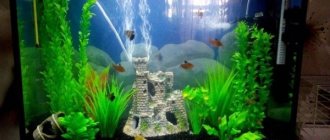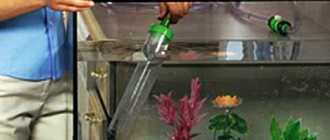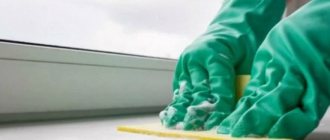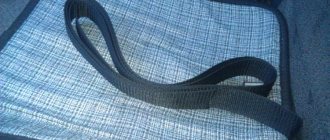Soil cleaning methods
Two main methods are used to clean soil:
- using a dirt suction device (or siphon);
- removing soil from the aquarium and placing it in a specially selected container, followed by rinsing under running water.
As a rule, the first cleaning option is used because it is less labor-intensive and does not take much time. You can extend the procedure over several days by dividing the bottom area into sections and sequentially treating one or two per day.
Cleaning with soil extraction requires greater efficiency, since the fish are temporarily resettled and are in unusual conditions. This can greatly harm the inhabitants of the aquarium, therefore, they try to complete the cleaning procedure as soon as possible.
Cleaning scraper
You can try cleaning vertical surfaces with a scraper. If it is not possible to purchase a special tool for cleaning the bottom of the aquarium, do it yourself. You don't need to use a regular sponge to clean. If the pond is not large in size, a regular razor, pre-attached wire or fishing line of the required length will do.
Specialists use bank cards that are no longer in use to thoroughly clean them. If you don’t want to get your brushes and clothes wet, you can easily attach the card to a wooden base. This tool is efficient and does not scratch at all.
How does a siphon for an aquarium work?
A mud pump, soil cleaner or siphon for an aquarium is a device consisting of several elements:
- transparent tube or funnel;
- flexible hose (rubber or PVC);
- pump with electrical or mechanical drive.
The general principle of operation is the same in any case - a transparent funnel is placed on the ground, water along with contaminants enters it and through a flexible hose enters a special trap (this is a small reservoir located immediately after the pump).
The water either enters a separate container, from which, after filtration, it returns to the aquarium, or it immediately goes back, passed through a mesh filter.
Mechanically driven siphons are cheaper, but the cleaning process with them is more labor-intensive; you have to manually operate the pump and filter the removed water before returning it to the aquarium. Siphons with an electric motor are more convenient to use, but somewhat more expensive.
1 - Mechanical siphon 2- Siphon with electric motor
As a rule, mechanical devices are preferred by owners of relatively small aquariums, while electric ones are purchased for large containers that require lengthy and thorough processing. At the same time, there is a limitation on the height of the walls - if they are higher than 50 cm, water can be poured into the battery compartment of the siphon.
In addition, you need to pay attention to the height of the glass (funnel). It is recommended to choose models with a suction part height of at least 20 cm. Then large soil particles will settle to the bottom without entering the hose and container with water or filtrate. This is an important point, since otherwise the amount of soil will decrease with each cleaning and require regular replenishment.
You should purchase siphons with a transparent tube (funnel) to control the cleaning process and stop it in time.
Battery Powered Aquarium Gravel
264 Reviews 563 orders(s)
Specifications: Condition: 100% Brand New Material: Plastic Color: As shown in the picture Power Source: 2 x 1.5 VC batteries (not included) Drain Pipe Length: Approx. 67cm/26.38in Intake Pipe Length (3pcs): Approx. 18cm/7.09in, 20cm/7.87in, 40cm/15.75in Total length: min. 58cm/22.83in, 72cm/28.35in. 95cm/37.40in (adjustable) Normal water level: 30cm. Water level: 72 cm. : 520L/h Weight: approx. 373 g
Package Included: 1 x Gravel Cleaner Main Body(Battery Not Included) 3 x Water Inlet Pipes 1 x Drain Pipe 1 x Strainer Bag 1 x Blackhead and Pimple Remover Tool 1 x Cleaning Brush;
Note: 1. Please allow 0-2cm differs due to manual measurement. Thanks for understanding. 2. Monitors are not calibrated the same, item color displayed in photos may be slightly different from the actual item. Price: RUB 650.05
BUY ON ALIEXPRESS
How is cleaning done?
You should use the siphon a few weeks after starting the aquarium, not earlier. Firstly, there will be no point in the procedure, since organic matter and food residues have not yet had time to accumulate. Secondly, the inhabitants of the aquarium are just getting accustomed to their new place, therefore, it is not advisable to disturb them.
The cleaning process, in addition to removing excess organic matter settled on the ground, involves removing part of the water. In some cases, it is filtered and returned back, in others it is simpler and topped up with clean water to the desired level.
Cleaning procedure:
- Prepare a siphon and a container for water (a regular bucket will do).
- Fill the siphon tube with water and immerse it in the aquarium. The free end must be lowered below the bottom level, otherwise the water will not flow by gravity (if an electric siphon model is used, this condition is not necessary).
- It is recommended to conditionally divide the bottom area into squares in advance so that cleaning is as thorough as possible. This especially applies to large aquariums.
- Using a tube, lightly stir up the soil, raising the turbidity. It is recommended to immerse it to the very bottom (to the glass) in order to siphon the entire layer of backfill and remove organic matter with maximum efficiency.
- Heavier soil particles will settle to the bottom, and organic matter and fine suspension will be picked up by the water flow and discharged into the prepared container.
- The process is controlled by monitoring the state of the flow. As soon as the water in the tube has become clear, the procedure is transferred to the next section of the bottom (or stopped altogether).
The more powerful the siphon, the larger the tube diameter required. If the water leaves too intensively, the soil itself may be sucked in, which is undesirable. It is necessary to organize the process so that only organic matter and suspended matter are removed, and the backfill layer remains at the bottom.
Important Details
Allows you to regulate the intensity of the water flow passing through the device. It is not very convenient to carry out a siphon without such a tap; you always have to pinch the drain with your finger or change its height.
Mesh in the fence.
Finding and installing such a mesh on a homemade device is not so easy, so many aquarists prefer a purchased option. The mesh in the intake part of the hose prevents pebbles in the ground from being drawn into the apparatus and protects small-caliber inhabitants of the tank from the same fate. They would hardly like a high-speed descent through the device’s hose followed by a swim in dirty water.
Siphon drain filter.
The water pumped out during soil cleaning can be reused, only, of course, it must first be separated from the removed dirt. If you use the simplest siphon design, there is only one way to do this: wait until the dirt settles at the bottom of the drain container. But if you bought a device whose drain is equipped with a filter (usually a small cloth bag), then you will immediately receive clean water suitable for reuse. The main thing to remember is: if the fish’s habitat has not been cleaned for a very long time, the pumped out water cannot be reused, even if a filter is installed on the drain of the device. Nitrites and ammonium salts contained in large quantities in the drained water will poison the tank environment and cause the death of all living organisms in it.
Loading …
Pros and cons of using a siphon for an aquarium
The positive aspects of cleaning soil using a siphon include:
- the ability to remove decaying organic particles;
- the danger of acidification of the substrate, which does not receive oxygen, is eliminated;
- the bad odor is eliminated, no harmful gases are released from the soil.
Flaws:
- the number of bacteria living in the upper layers of the substrate decreases, which leads to a decrease in biofiltration ability;
- Nutrients are removed from the soil, which worsens the conditions for keeping plants;
- there is a risk of damage to the roots of aquatic plants.
When choosing a method for cleaning an aquarium, you need to weigh all the pros and cons so as not to disturb the ecosystem and not worsen the living conditions of fish and other organisms.
When not to siphon
There is no need to clean the aquarium with a siphon when it is completely planted, there are a lot of shrimp, small snails and fry. Plant roots penetrate the soil and act as a natural aerator, releasing oxygen. Therefore, souring does not occur. The situation is different when the plants have unbranched, weak roots, and the soil lies in a thick layer.
You should definitely not siphon the soil in the following cases:
- the aquarium was launched less than two weeks ago;
- the colony of nitrifying microorganisms has not yet grown;
- Only aquatic plants are grown in the tank, and the siphon actively washes out the nutrient substrate.
There is a sure way to check the condition of the soil with plants: move it with a stick. If bubbles appear and cloudiness rises, it’s time to siphon. This means that the decay products of aquatic life rise up and become a source of pathogenic bacteria.
Which soil is most in need of cleaning?
Mostly soil without plants needs cleaning. It is recommended to siphon it monthly (in small aquariums you can repeat the procedure twice a month, sometimes 3 times a week). This will help maintain the concentration of nitrates and phosphates at a safe level.
Herbalists siphon much less often - once a year, or even less often. The fact is that plants form an ecosystem with a closed consumption cycle. The settling particles of organic matter and decomposition products become a nutrient medium for plants and do not require frequent cleaning. For cleaning, it is recommended to use a special metal tube with a flattened working end so as not to damage the roots.
Arend van den Nieuwenhuizen
Aquascaper
If nutrient soils are used as soil, siphon cleaning cannot be used. During the cleaning process, nutrients will be removed from the granules and sludge containing useful substances will be removed. Soils are not washed at all, even before adding them to the aquarium. This allows you to preserve the working qualities of the soil, the service life of which is already quite short (it is generally accepted that the service life of soils does not exceed 1.5-2 years).
— Arend van den Nieuwenhuizen Aquascaper
If the amount of organic matter in the soil begins to worry, and siphoning is not possible, it is recommended to add shrimp or snails that can destroy excess waste and silt.
Vegetation treatment
If there is living vegetation in an artificial reservoir, then it also requires care and purification. Plants can be cleaned at home, following certain rules:
- Plants do not like transplants.
- Vegetation is not processed during every harvesting operation.
- Spoiled and damaged leaves are cut off.
- Overgrown plants must be removed so that they do not become an obstacle to the free movement of fish.
- Pruning should be done as the bushes grow.
- Overgrown bushes should be thinned out so that they do not interfere with the penetration of light into the container.
- If it is necessary to remove a plant by its roots, the manipulation is carried out as carefully as possible to prevent the rise of turbidity from the substrate.
Making a siphon with your own hands
The price of a regular mechanical siphon is in the range of 500-700 rubles. This is quite affordable for aquarists, but many prefer to make siphons themselves, not wanting to waste time searching or waiting for the device to be delivered from online stores.
For a homemade siphon you will need:
An empty plastic bottle (0.5 l) with a lid, preferably transparent.
Shoe knife.
A piece of hard plastic hose 50-60 cm long.
1.5-2 m of flexible hose with a diameter of 10 mm.
To make a siphon, you must perform the following steps:
- The plastic bottle is cut so that a funnel of the required diameter is formed. For more active water suction, the edges can be made jagged.
- A hole is made in the lid for connection to a rigid tube. An adapter is installed on the free end to connect a flexible hose.
- All connections are sealed with electrical tape (you can use silicone sealant).
At this point, the production of a simple siphon can be considered complete.
Disinfection
Do-it-yourself electric vacuum cleaner for an aquarium
Disinfection from unwanted and pathogenic bacteria, fungi, parasite eggs, etc.
This is especially important if you collected the substrate in a pond
Why is this needed:
- Fewer parasites. Parasite eggs are usually well protected from various external influences and can remain viable for a long time. Disinfection is the only way to get rid of this problem. Yes, it is impossible to completely protect your charges from parasites, but you need to make every effort;
- The probability of water blooming is lower. The soil is a real paradise for algae. Tens and hundreds of thousands of these microorganisms accumulate on its particles, which, under suitable conditions, can multiply so intensively that they color the water. And these are not only “aesthetic” problems, but also very real ones, ranging from the absorption of all nutrients for plants to provoking diseases of fish and shrimp;
- Fewer diseases of aquarium inhabitants. It is unlikely that you will be able to find soil collected from the natural habitat of exotic fish species. And if it is obtained from completely different bodies of water, the microorganisms will be different. Your fish simply are not immune to them.
Soil disinfection is an extremely important stage of work. Regardless of where you got the substrate, you need to disinfect it and only then put it in the aquarium.
How to do it:
- Choose a disinfection method. The simplest and most popular is calcination. It consists of heating the substrate to a temperature above +100°C in the oven. The second is boiling in water for 15-20 minutes. The third is the use of a 10% chlorine solution. Which one is right for you - choose for yourself, they are equally effective. Only in the latter case will it be necessary to make more efforts to remove all chlorine from the substrate after disinfection;
- Do not hurry. Most microorganisms will die quickly, but parasite eggs can remain viable even when briefly heated to temperatures above +100°C. Therefore, either choose calcination (temperature above +100°C) or long boiling (at least 15 minutes);
- Cool the substrate, rinse and dry again. After disinfection, in some cases small particles may appear (in small quantities) that must be removed. And after disinfection with a chlorine solution, rinsing is mandatory.
Frequently asked questions
Let's consider some questions that novice aquarists constantly have regarding the procedure for cleaning the soil with a siphon:
Do I need to remove driftwood and other decorative elements before cleaning?
It is not advisable to touch snags. If access to some areas is difficult, it is recommended to use a special funnel attachment with a curved and thinner tube.
Do I need to remove the fish before using the siphon?
No, there is no need to remove the inhabitants of the aquarium, but you must act carefully, trying to protect the fish from getting inside the funnel.
When can you siphon an aquarium for the first time?
No earlier than 14 days after launch (in practice, this period is often extended to a month or more).
How to reduce the frequency of soil cleaning?
To reduce the frequency of cleaning, it is recommended to reduce the number of fish and plant the aquarium with plants with a strong root system. In such conditions, you can do without using a siphon altogether.
What should be done if the siphon does not absorb water well?
You can increase suction by changing the diameter of the funnel. The smaller it is, the greater the water suction force. However, you should not reduce the size of the funnel too much, otherwise it will begin to draw in soil.
How to visually determine that it is time to siphon the soil?
Rotten plant roots indicate the need for cleaning. In addition, you can perform a test using a stick immersed in the ground. If gas bubbles come out of it, then it’s time to siphon the aquarium.
Cleaning an aquarium using a siphon allows you to quickly and without special preparation remove waste and food residues that have settled on the ground. The procedure is quite simple and does not require the use of complex equipment - you can make a siphon yourself.
There are some contraindications that you need to know about in advance (using a siphon in herbalists or cleaning soils). A correctly performed procedure will allow you to establish a comfortable habitat for the fish and eliminate the bad smell from the aquarium.
Storage and maintenance
In order for the siphon to work for a long time and perform its duties efficiently, it is important not only to purchase a good model or make a suitable device, but also to store it correctly.
After using the siphon, it must be disassembled and all parts must be thoroughly washed with soapy water or a special detergent with an environmentally friendly composition. Next, they need to be thoroughly wiped or dried well. It is better to store unassembled.
The siphon undoubtedly plays a big role in maintaining the cleanliness of an artificial reservoir and preserving the health of its inhabitants. Every aquarist should have this device. Having studied all its varieties and instructions for making it yourself, you can, based on your preferences, choose a suitable device that protects the cleanliness of the aquarium.
Varieties
Choosing the best soil for your aquarium
An aquarium is an artificial system that must be maintained in balance at all times. Without proper care, unfavorable conditions arise that lead to the death of the inhabitants. Aquarium cleaners are divided into two main types: electrical and mechanical.
Electrical
This species can be used in both freshwater and saltwater aquariums. They are especially useful in aquariums with a lot of vegetation. Electrical equipment is characterized by high power. Another characteristic of the devices is their extensive suction power. The device will quickly collect all the debris from the bottom, including from hard-to-reach places.
Suction of small fish and fry is excluded with a device that has a special filter. If you follow the instructions, the functionality of the electrosiphon will be maintained for a long time. Installation is possible anywhere in the aquarium; even a beginner will not have any questions with this issue.
The operation of a vacuum cleaner for cleaning is impossible without a special pump. With its help, water is drawn in, which, passing through the filters, is cleaned of dirt. Some models have special cartridges installed inside them. They are distinguished by inclined planes that attract dirt. The system effectively filters aquarium water. Cartridges are washed over time or replaced with new ones. The water flow in a clogged appliance becomes weaker and efficiency decreases.
Mechanical
great depth. In containers half a meter deep, water can be filled. This type differs from the previous one in a more primitive design. The manual option is good for beginners who are just trying themselves in the aquarium business. The models are simple, but require additional devices that can be used to clean glass. In a mechanical product, a regular rubber bulb is needed to pump water. It is additionally equipped with a funnel or a regular cylindrical plastic body.
It is very convenient when this part is transparent. You can immediately see small inhabitants and exclude their death. To drain water from a mechanical siphon, you need some kind of container. For it you need to find a hose of optimal length. To get started, just squeeze and unclench the rubber bulb. This will require some effort and dexterity.
An alternative siphon option could be a battery-powered device. It does not provide for draining water, which already makes the task easier. No hose required for operation
An important feature is the regulation of the flow and the presence of a special compartment called a trap











